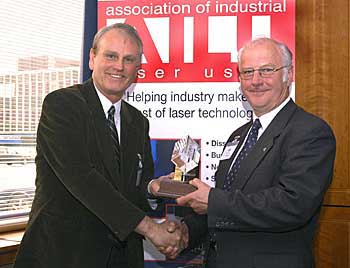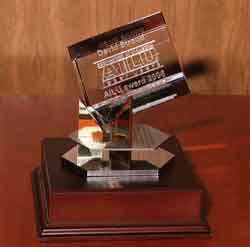2006 - David Stroud

The AILU AWARD for 2006
went to
Dave Stroud
Every year AILU presents an award to recognise ‘an individual who has made an outstanding contribution to the industrial use of lasers in the UK’.
David Stroud, who retired from Rolls Royce in 2002 after 25 years with the company, is the winner of the 2006 AILU Award in recognition of his work in introducing laser applications into the aerospace industry.
The award's sub-committee recognised that during a period of scepticism on the use of lasers in aircraft construction, David played a big part in the transfer of laser drilling of combustion components from process development into production. In so doing, he supported and encouraged the adoption of laser use in the aerospace industry to the benefit of the communities of laser users and laser service suppliers.
The presentation of the award to David will be the climax of this year's annual members' meeting on 11 April, which by a happy coincidence is being held at Rolls Royce, Derby

David Stroud - his work at Rolls Royce
Reflections by Arthur Corfe
David started work on lasers in 1982/83 when Rolls-Royce made the decision to replace ED M with lasers for the small cooling holes required in their static hot end components, ie, combustors and turbine Nozzle Guide Vanes (NGVs). J K Lasers had made the first non-capacitor discharge pulsed Nd:YAG laser and this proved to give Rolls-Royce the benefits they needed to move their component manufacture forward and to be more competitive in the market. David was involved with the build and commissioning of this first machine, a 5-axis fully enclosed system with galvanometer trepan optics and 300 W mean laser power. This machine was installed in Rolls-Royce and from that day until he retired David was influential in all laser drilling developments in the organisation.
This first machine was used to develop the hole quality required for Rolls-Royce components and David was instrumental in provisioning a Quality Acceptance Standard for features such as hole shape, surface finish, recast layer and micro cracking. In time the machine was transferred to a combustor manufacturing facility and in 1986 the 2nd machine was on the way. During this 1st phase, Dave was quickly networking around the world and he was offering consultancy advice from as far a field as Taiwan, Holland, France and the USA.
J K Lasers had become Lumonics and this 2nd machine was much smaller and specifically designed for NGVs. It housed the new JK400, a 400 W mean power laser that was to be the main stay of the Rolls-Royce lasers until the advent of the JK400 twin rod. In 1986 the 3rd machine was ordered from Raycon Corporation, and David was on his way to the USA, the first of many visits overseas commissioning machines, conducting research or providing consultancy.
The number of systems at Rolls-Royce was growing, and other engineers were becoming involved and David was now providing a supportive role in training, as well as guidance on the use of lasers and care and maintenance of the machines. Machines were now also coming from Lastec, Laserdyne and Trumpf.
During his time in Rolls-Royce, David was involved in much fundamental research from shaped holes, techniques, optics, back-wall strike prevention, break-through detection, etc, that resulted in several patents to his name.
David built up a huge network of associates around the globe and today many of these are his personal friends. Since his retirement from Rolls-Royce David has remained active and his knowledge and experience continues to be recognised and respected within the laser field.

